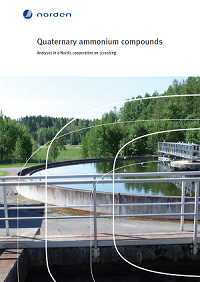
| Publication Year | 2014 |
| Publisher | Nordic council of ministers |
| Report Homepage | http://norden.diva-portal.org/smash/record.jsf?pid=diva2%3A760465&dswid=-3070 |
| Publication Identifier | TemaNord 2014:556 |
| ISBN | 978-92-893-3813-4 |
Information
Do fish need hair conditioner?
Nordic study reveals emerging contaminants in the environment that origin from everyday consumer products.
Ingress:
A new screening study from the Nordic environment find widespread occurrence of Behentrimonium recently described as a possible new emerging contaminant. Although used in consumer products such as cosmetics and not intended for discharge to the environment, this chemical was now found in all sewage treatment effluent and sludge samples, as well as in marine sediments and fish.
Behentrimonium is a chemical belonging to a chemical group called quaternary ammonium compounds, (QACs). In the present study, environmental samples from the Nordic countries Denmark, Faroe Islands, Finland, Greenland, Iceland, Norway and Sweden has been investigated. QACs are widely used as ingredients in industrial applications and may be found in household products including fabric softeners, detergents, disinfectants, preservatives, and personal care products.
In general there was a widespread occurrence of QACs in all included matrices. Concentration in effluents varied greatly. A majority of the “high concentration” effluents showed, even after ten times dilution, concentrations of the two QACc alkyltrimethyl ammonium (ATACs) and/or benzalkolium (BACs) that could pose a risk to the aquatic environment. Ecotoxicological data is lacking especially for long chained ATACs.
The relatively few samples and sample types implies that the results will only give a ”snap shot” of the situation, but one with a wide geographical coverage.
The project is financed and supported by the Nordic Council of Ministers through the Nordic Chemicals Group and the Marine Group as well as the participating institutions. The chemical analyses have been carried out by IVL Swedish Environmental Research Institute.